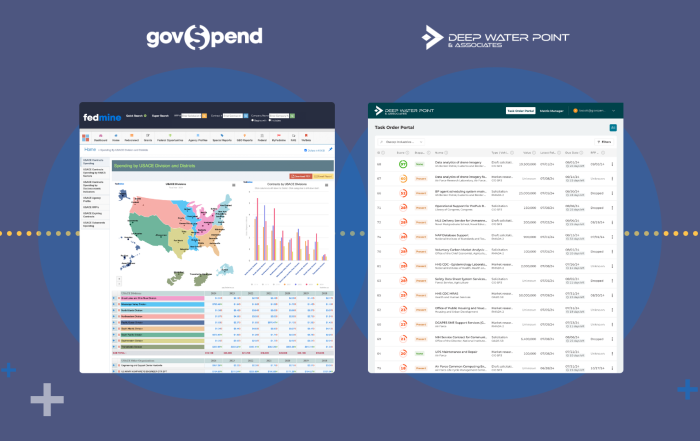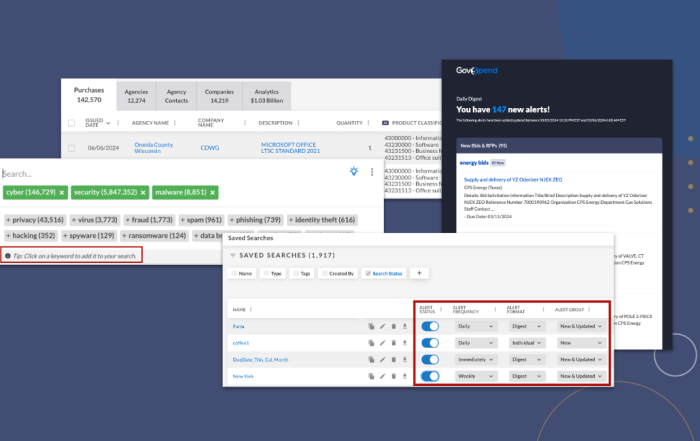
If you are a new vendor who is interested in selling to the government, it can be a bit confusing with all of the government jargon out there (or even if you’ve been selling for years!). We have compiled a list of commonly used terms or acronyms you may hear when pursuing business with the government to help guide you through the process.
RFP (Request for Proposal) – Government agencies can purchase in a variety of ways, and depending on the dollar amount, the agency will have to issue a RFP for fair and open competition. In prior years, the agency would post a notification in the newspaper for what they needed, now the internet has made it easier to find agencies looking to purchase what you sell. An RFP is typically issued when the amount being spent exceeds the agency’s discretionary spend and will include a written summary of the products/services needed (referred to as “Scope of Work”).
Any vendor can respond to the RFP by completing the document BUT only the vendors who can meet all of the criteria listed will be considered. It is important to follow all of the instructions on the RFP. If you miss any of the sections, do not include requested documents, or send your proposal a minute late (yes, just one minute), the agency will not consider your proposal for review. This may sound harsh, but this is the only way to keep the process fair amongst competition. Sometimes a government agency will have a window (3-7 days) in the beginning for questions, allowing vendors to clarify any requests in the documentation. No one is perfect and agencies can issue an addendum to the RFP if changes to the requirements are discovered during the Q & A period. After the question period is over, the agency will cease communication with vendors until the due date of the RFP. The evaluation process will begin and there can be a second round of evaluation for a “short list” of vendors to present before making the final decision. Depending on the requirements, this process may take anywhere from 3-12 months.
Piggybacking or Piggyback – The term piggyback is used when an existing contract can be utilized for purchasing by another agency in addition to the one you are working with. Let’s say you have won a bid/RFP from the City of Austin and have included verbiage in the agreement that allows other agencies to purchase your products/services. If the City of Houston follows the same procurement process as the City of Austin, the City of Houston can avoid going through the bid/RFP process and purchase your products/services by piggybacking on the deal you won with the City of Austin. This helps save the agencies time and resources, making it easier for them to purchase from you and shortening the evaluation for the procurement process.
PTAC – This term stands for Procurement Technical Assistance Center, also known as APTAC (Association of Procurement Technical Center). There are roughly 100 PTACs that are available across the Unites States that offer free guidance for anyone looking to do business with the government. PTACs are funded by the DLA (Department of Logistics Agency) and hosted by a state agency to provide a physical location for meetings. This organization is a great place to start for anyone looking to sell to the government, especially in the Federal market because it covers that area in more depth.
Bid – This term is similar to an RFP in the sense that it is a formal process for purchasing that requires a vendor to complete documentation to be considered for the opportunity. There are purchasing agents across the country that will dispute the true definition of bid vs RFP but to keep it simple, this is a request for work needed to be done by an agency.
Regardless if it is a bid or RFP, the most important part is following the requirements for the submission, and making sure to submit on time!
RFQ (Request for Quote) – This is a more informal process compared to an RFP, used when an agency needs something that falls into a lower spending threshold. This allows an agency to contact a few vendors through email or phone, asking for a price of the products/services needed, and then choosing a company to work with for the project. To be in compliance with procurement procedures, the agency might need a minimum of 3 quotes before selecting the vendor of their choice. Something important to note, the cheapest price does not always win. That’s right, the government procurement office wants the best VALUE. Some other factors that are considered are: previous experience, support offered, and warranties could be the deciding factor on best value. The pros to this method is that less paperwork is required compared to the RFP process and purchases can be executed in days to weeks, instead of months.
Sole Source – The simplest way to understand sole source is if you can say your company is the ONLY place to buy this product or service. Sole source is a method of procurement that allows an agency to buy directly from the vendor without the hassle of competition. If you have a product or service that is unique, draft up a document called a “Sole Source Verification Letter” to share with agencies, letting them know you are the only place to get this product or service. This can be somewhat of a gray area when it comes to procurement because it can be difficult to validate, however, if the agency is open to this buying process, it can save you a great deal of time and paperwork.
Discretionary Funds – This is a spending limit that allows government agencies to have more control over who they want to work with for purchases outside of the bid and RFP process. For example, the City of Austin has a discretionary fund of anything below $5K. This means they can contact vendors for pricing without going through a formal solicitation process as long as it is below the discretionary fund of, in this case, $5K.
Agency – This is a broad term that can be used across multiple types of governments. A city is an agency, a school is an agency, a county is an agency, the Department of Transportation is an agency, and the Army is an agency. The most common agency types are broken into two categories: SLED (State, Local, and Education) and Fed (Federal) .
Validation Marketing – The process of establishing social awareness to promote your business as a trustworthy company through multiple channels. This includes having an updated presence on social media, news outlets, customer reviews, BBB reviews, websites and search engine results.
Co-op (Cooperative Agreement) Local government agencies are advocates for using these agreements in lieu of the bidding process in order to simplify the buying and selling process. A co-op can be a private organization, or public lead organization, that has properly vetted companies for various products and services with established discounted rates.To get on a co-op, you will go through an evaluation process just as you would for a bid to stay in compliance with agencies purchasing procedures. Once you are selected as a primary vendor, you can market to agencies, letting them know they can buy your products/services from the cooperative agreement, shortening the buying process and delivering what they need at a fair price.
FOIA (Freedom of Information Act) – Published in 1967, FOIA is a federal freedom of information law that requires the full or partial disclosure of previously unreleased information and documents controlled by the United States government upon request. This means that any tax paying citizen can contact a government agency and know where the money is being spent to help you understand what price the agency has paid in the past for products and services, also knowing who they worked with for a specific project.
There are hundreds of terms you might come across during your process of selling to the government. We are here to help you sift through all this jargon so you have a better understanding of the government marketplace and procurement process.
If you have more questions about any of these terms, click the link below and schedule a personalized free demo with someone from our team!




